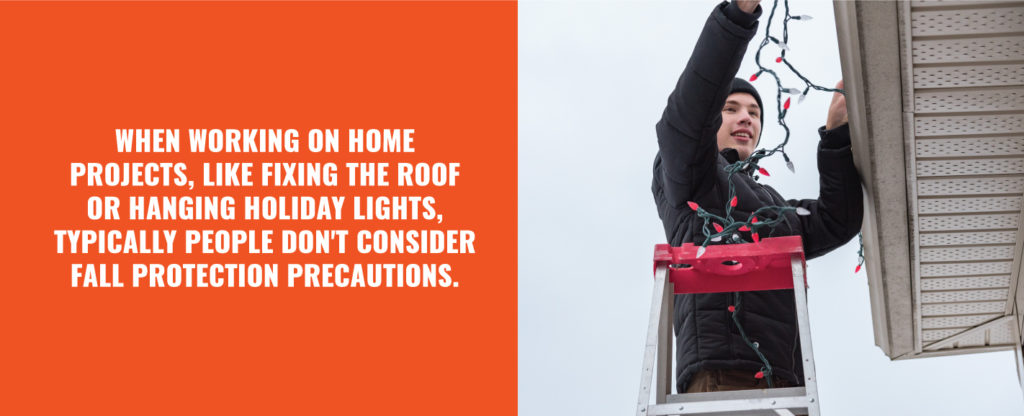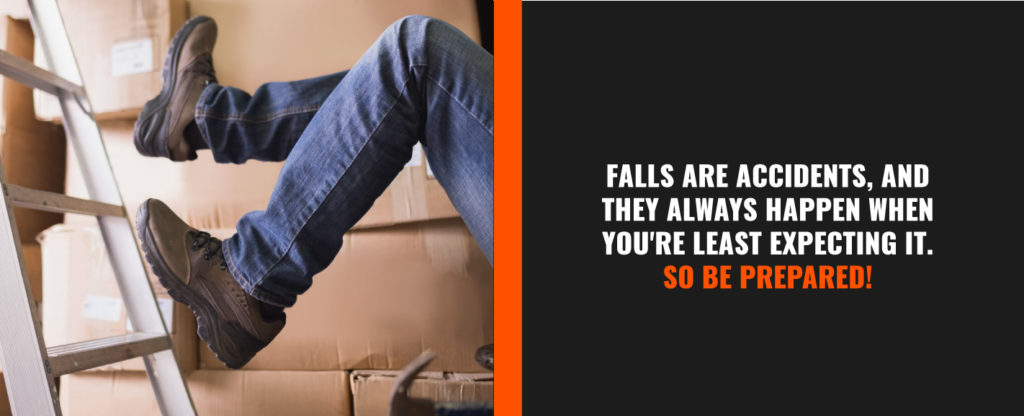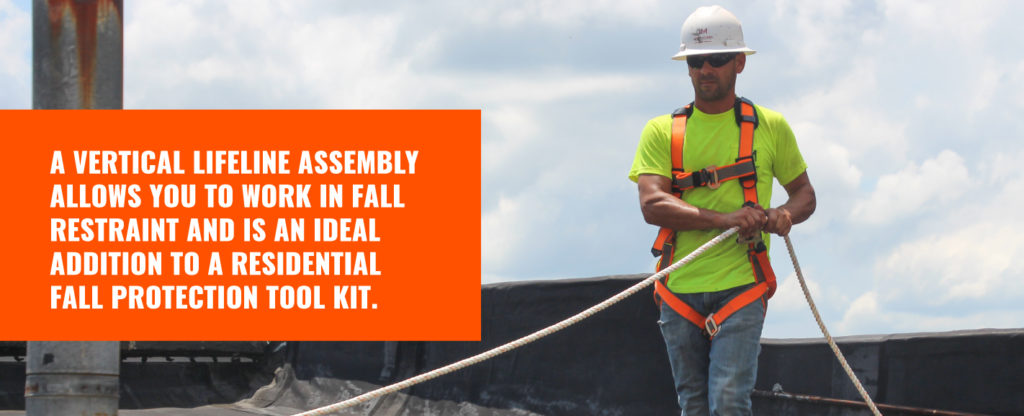What kind of fall protection should I use at my house?
On this week’s episode, Greg and David talk to us about home fall protection precautions. What kind of fall protection should you use while working in your own home? When working on home projects, like fixing the roof or hanging holiday lights, typically people don’t consider fall protection precautions. Falls are accidents, and they always happen when you’re least expecting it. So be prepared! A permanent roof anchor is a great fall protection tool and can be installed under your roof shingles. A vertical lifeline assembly allows you to work in fall restraint and is an ideal addition to a residential fall protection tool kit.
https://youtu.be/q5T15DUFW0M
Home Ladder Safety
Typically, work on your own home is going to involve a portable ladder. Hanging lights, changing a bulb, painting just out of arm’s reach, all of these common scenarios are perfect for a ladder. While completing projects, remember that following proper ladder safety is key. Some fall protection requirements include; making sure the ladder is extended 3 feet over the edge of the roof and having 3 points of contact on the ladder at all times is a good start, but there is much more to consider.
In 2022, the Occupational Health & Safety Administration (Federal OSHA), provides the following Quick Card on Portable Ladder Safety. Falls from portable ladders are one of the leading causes of occupational fatalities and injuries.
Read and Follow Labels/Markings
Pay close attention to labels and markings on the ladder, which provide crucial information including:
-
Maximum Length and Load Capacity
-
Duty Rating
-
Material
-
Height
-
Usage Instructions
-
Safety Warnings
Ladder safety precautions are extremely important in any workplace or household setting, serving as a critical safeguard against potentially life-threatening accidents. By observing usage guidelines, individuals lessen the risk of falls, injuries, and even fatalities, ensuring a safe and secure environment for all. Prioritizing ladder safety not only protects individuals from harm but also promotes productivity and efficiency by minimizing downtime caused by accidents or injuries.
Safety Precautions:
-
Avoid Electrical Hazards: Check for overhead power lines before handling a ladder, and refrain from using metal ladders near power lines or exposed energized electrical equipment.
-
Inspect Before Use: Always inspect the ladder prior to use to ensure it is in good condition.
-
Maintain Three-Point Contact: Maintain three points of contact on the ladder while climbing.
-
Proper Climbing Technique: Keep your body near the middle of the step and always face the ladder while climbing.
-
Use for Intended Purpose: Only use ladders and approp
riate accessories for their designed purposes. -
Avoid Slippery Surfaces: Ensure ladders are free of any slippery material on the rungs, steps, or feet.
-
Stability: Use ladders only on stable and level surfaces, avoiding placement on unstable bases or surfaces.
-
Secure Placement: Do not move or shift a ladder while someone or equipment is on it.
-
Extension Ladders: Ensure proper extension above the support point and set up at the correct angle.
-
Secure Ladder Placement: Secure ladders to prevent displacement in locations where they may be shifted by other work activities.
-
Engage Locks: Ensure all locks on extension ladders are properly engaged.
-
Stay within Load Rating: Do not exceed the maximum load rating of the ladder.
Specific Recommendations for Step Ladders:
-
Ensure spreader bars are fully extended and locked before climbing.
-
Avoid standing on the top cap or the step below the top cap.
Additional Safety Measures:
-
When using safety posts or ladder stabilizers, ensure proper attachment and regular inspection according to the manufacturer’s instructions.
-
When working at heights requiring fall protection, use ladders with integrated fall arrest systems or attach personal fall arrest systems to secure points.
-
Regularly inspect the bottom brackets or feet of the ladder for wear and damage, replacing worn or damaged parts promptly.

The Vertical Lifeline Assembly
For home improvement projects, a vertical lifeline assembly is a really simple and effective piece of fall protection equipment. If you’re working on your roof, you may use a VLA in fall arrest applications, where the system stops a person who is already in the process of falling and bringing their body to a halt. This is one way to use the VLA, but they are most used in fall restraint scenarios where the person operates within a limited amount of space and the system stops them from reaching a dangerous fall hazard. To use a vertical lifeline fall protection device, you must first use the self-locking snap hook to attach the poly-rope to an approved anchor point. Then, measure out the appropriate distance to allow the worker to move around safely in the work environment without reaching the edge or crashing into the ground if a fall occurs. Make sure to factor in the length of the shock pack just in case the pack becomes deployed. Use the rope grab positioning device to solidify your location along the rope and lock it into place. Now you are safe to move around the workspace and avoid the fall hazards.

Using a Vertical Lifeline Assembly
To use a vertical lifeline assembly, you must first use the self-locking snap hook to attach the poly-rope to an approved anchor point. Then, measure out the appropriate distance to allow the person operating to move around safely in the work environment without reaching the edge or crashing into the ground if a fall occurs. Make sure to factor in the length of the shock pack just in case the pack becomes deployed. Use the rope grab positioning device to solidify your location along the rope and lock it into place. Now you are safe to attach your full body safety harness to move around the roof and avoid the fall hazards.

A permanent roof anchor is an ideal tool to install on your home roof. It is a versatile and lightweight safety solution that can be installed beneath the shingles on your roof and blends extremely well to not detract from the aesthetic of the roof. Designed for wood rooftops and permanent applications, the Malta Dynamics roof safety anchors have two D-Ring ends made from alloy steel and an 18″ stainless steel body for an exceptionally long life.
You can install these roof anchors during construction, or they can be added secondarily to create a reliable, long-wearing roof anchor that is easy to use and low profile enough to leave it installed. Simply attach your lifeline and full body harness to the anchor point and get to work.


Greg Brown
President of Malta Dynamics
About the Reviewer:
Greg Brown has a diverse background, having worked in various industries such as utilities/communication, oilfield, and manufacturing. In 2018, he embarked on a mission to serve these industries by offering innovative safety products. Over the years, Greg has traveled extensively, visiting numerous sites and engaging with thousands of dedicated individuals to promote safety. Malta Dynamics takes a unique approach to safety, with a close-knit family of construction and manufacturing workers, providing Field Tested, Field Approved solutions to ensure the well-being of workers.
Have a fall protection question?
Submit your question, and you could be featured on Dynamic Discussions!
